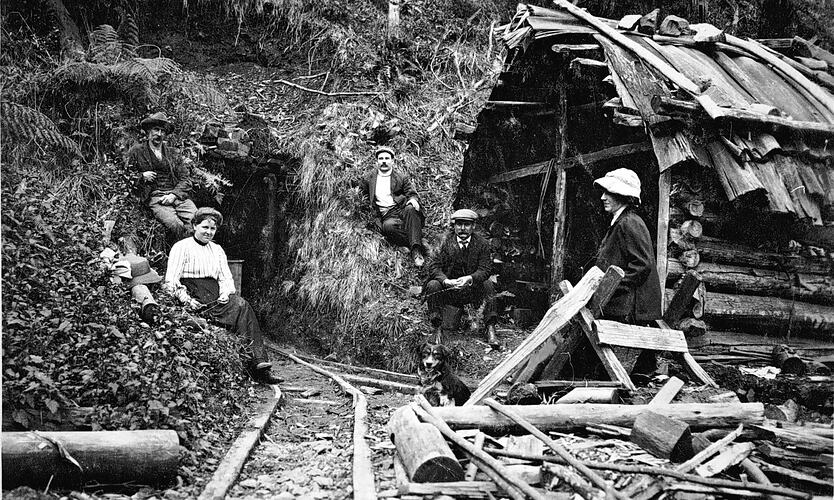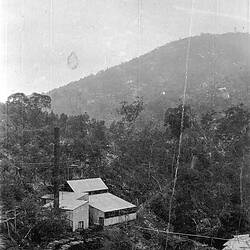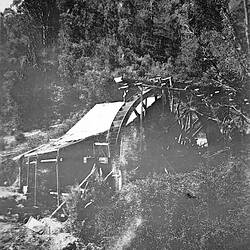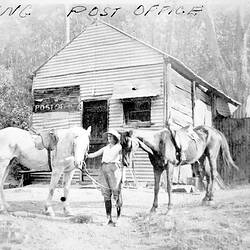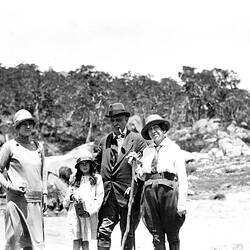Summary
Stirling was a small mining settlement on the Haunted Stream goldfield situated in rugged mountain country between Bairnsdale and Omeo. Alluvial gold had first been discovered in the area in 1863, causing a small rush that soon petered out. The discovery of several rich quartz reefs between 1882 and 1884 led to a revival with the expanding settlement formed near the junction of Tierneys Creek and the Haunted Stream being named Stirling in 1889, in honour of the government geologist and surveyor, James Stirling (1852-1909), who had done much to assist the development of mining prospects throughout the district. Stirling had arrived in the Omeo district in 1877, working initially as a surveyor and foreman with the Crown Lands Department, before transferring to the Mines Department as an Assistant Geological Surveyor in April 1887. The town soon boasted two hotels, a wine saloon, boarding houses, a general store, butcher, baker, billiard room, post office, police station, recreation ground and Mechanics Institute Hall - which doubled as a schoolroom and church. The Haunted Steam State School (No.2845) opened in October 1887 and had an average attendance of 15 pupils throughout its first two decades.
The formation of the Stirling Proprietary Gold Mining Co. (No Liability) in 1898, marked the beginning of an era of renewed interest in quartz mining on the Haunted Stream goldfield, with new capital flowing from investors in Melbourne, Ballarat and Bendigo, and the establishment of over a dozen new mines. As mining activity extended up the winding valley, another settlement was established in 1902 near Sheepstation Creek, about 10 miles (16 kms) upstream of Stirling. It was named Dawson City after its far more populous namesake, which in the late 1890s had become world-famous as the epicentre of the Klondike goldfields in Canada's Yukon Territory, being the destination of the last great international goldrush of the 19th century.
Around Dawson City on Haunted Stream a small cluster of quartz mines developed, operated mainly by co-operative parties and private partnerships. The Stirling King mine worked by W.H. Sawyer & party was one of the more successful mining enterprises at Dawson City, producing some 1,370 ozs of gold, worth over £5,000, from 1,873 tons of quartz, between 1902 and 1913, at an average grade of 15 dwts/ton (23 g/tonne). The mine was developed through two adits into the hillside and by 1908 had acquired a small water-powered 6-head stamp battery, possibly the plant that the Ballarat-based stockbroker and mining investor, Alex Lamb, was reported to be installing in 1902 to undertake public crushings. By the outbreak of World War I, the settlement at Dawson City had been abandoned and two years later only three small co-operative mining parties were still active on the whole of the Haunted Stream goldfield. At the end of the war most of the remaining crushing plants and other equipment were broken up with explosives and removed for scrap.
Description of Content
A group of men and women at the entrance to the 'Silver King' mine, at Dawson City (near Stirling), on the Haunted Stream goldfield. The people depicted are (from left to right): Mrs and Mr Sawyer (both seated on embankment); Arthur Astall (seated on embankment in centre); Mr W. Collings (seated centre right in front of hut); and Mrs Alston, the photographer's wife (leaning against a wooden saw-horse in the foreground and facing the others). A (collie?) dog is seated on the ground in front of Mr Collings facing the photographer. In the centre of the photo is the mouth of a tunnel, or adit, excavated into the hillside forming the entrance to the mine. A wooden portal frame supports the adit mouth and the corner of a riveted iron mine truck is just visible inside the entrance. A wooden-railed tramway extends from the mouth of the adit, with the rails partially capped by protective metal strips at a point in the middle ground where the rails pass through a fork or junction and curve to the left. To the right of the image is a rough shelter built of interlocked horizontal logs in a 'log cabin' style, with a bark roof, possibly used as a mine workshop, store or blacksmith's shop. In the right foreground in front of the saw-horse is a scatter of split timber off-cuts and sawn logs, possibly leftovers of materials being prepared for use as props and laths for underground support within the mine.
More Information
-
Collection Names
-
Collecting Areas
-
Acquisition Information
Copied from E. J. Conn, 09 Nov 1987
-
Place & Date Depicted
Stirling King Mine, Dawson City, via Stirling, East Gippsland, Victoria, Australia, 1911
Originally identified as 'Dawson City Mine' based on information provided by the contributor. The identification has been updated based on information provided by Michelle Stewart (DC Inq#76245, 28/07/2020) describing annotations found on another copy of the same photograph. -
Photographer
Mr Harold Alston, Stirling, Haunted Stream, East Gippsland, Victoria, Australia, 1911
Harold Alston was previously incorrectly identified as a person depicted. Information on the photographer and people depicted updated after receipt of additional information from Michelle Stewart (DC Inq#76245, 28/07/2020). Harold Alston was the youngest son of Thomas Alston J.P., a Glasgow-born goldrush immigrant of 1852, who became a prominent Melbourne draper and silk merchant, and Margaret neé Peacock. He was born on 11th June 1879 at the family residence 'Braemar', 56 Barkly Street, St Kilda, Victoria. After training in Mining Engineering at the Ballarat School of Mines, we worked for a period of about six months as Manager of the Union Gold Mining Co. at Diamond Creek, in 1907, before marrying Elizabeth Martha Colquhoun, at his parents' former residence on 5th December 1910. The newly-wed couple moved to Stirling, on the Haunted Stream goldfield in East Gippsland, where Harold was employed as a mine manager, most likely by the Hans Consols Gold Mining Company (No Liability), registered in July 1911, which was the last public company to be engaged in mining operations on the Haunted Stream goldfield. The company spent about 15 months in further prospecting the former Hans and Jorgenson leases, which had both been major producers on the field over earlier years, but little further gold was produced and the mine closed with its leases, plant and machinery, once valued at £24,000, being sold off at public auction in December 1912. Harold and Elizabeth Alston returned to Melbourne purchasing a 56-acre property at Diamond Creek, which Harold used his engineering skills to turn into a fine irrigated orchard. He became a prominent member of the local community and one of Victoria's best known horticulturalists noted for his knowledge of both fruit cultivation and flower growing. He died at home on 13 August 1956, survived by his wife and two children. -
Person Depicted
Mr William H. Sawyer, Dawson City, via Stirling, East Gippsland, Victoria, Australia, circa 1911
William Henry Sawyer was born at Ballarat, Victoria, in 1872, to parents Henry and Mary neé O'Brien, and probably gained his early mining experience there before moving to Gippsland, where he worked for about a decade from 1903 to 1913 as the leading partner of the Stirling King mine at Dawson City. In 1911, he married Emma Rachel Jolly who joined him at Dawson City, where they lived until about 1915, before moving to the Bairnsdale district, where four children were born and William found work as a labourer, possibly on the construction of the Bairnsdale to Orbost Railway. By the early 1930s William was employed as a ganger on the Whittlesea Railway, while Emma was appointed caretaker at the Mernda Railway Station and the family lived in a railway cottage near the station. Emma died unexpectedly from a heart attack in 1934 and William remarried to a spinster Mary Ann Howden in 1942, by which time he was living in retirement at "St Clair", Benson Street, Belgrave. He died on 29th January 1955 at his daughter's house in Reservoir, being survived by five children. -
Person Depicted
Mrs Emma R. Sawyer (neé Jolly), Dawson City, via Stirling, East Gippsland, Victoria, Australia, circa 1911
Born Emma Rachel Jolly, at Echuca, Victoria, in 1888, to parents George Edward and Rachel neé Allen. Her father was a constable with the Victoria Police who had served for 13 years at Brunswick, prior to being transferred to Lucknow in February 1904, bringing the family to the Bairnsdale district. In 1911, Emma married William Henry Sawyer, a miner working at Dawson City on the Haunted Stream goldfield north of Bairnsdale, where the couple lived until about 1915. They had four children born at Bairnsdale - Alma Doreen (b.1912), George Henry William (b.1913), Rita Elizabeth (b.1916) & Merle Alice (b.1919), and a subsequent son Tom. By the early 1930s the family had moved to the northern outskirts of Melbourne where William was employed as a ganger on the Whittlesea Railway and Emma was appointed as station mistress, or caretaker, at Mernda Railway Station. She died on the evening of Saturday 24th November 1934, after collapsing from a suspected heart attack on the train at Northcote, while travelling home following a day spent visiting friends in Yarraville with her daughter. She was only 46 years of age. -
Person Depicted
Mr Arthur S. Astall, Dawson City, via Stirling, East Gippsland, Victoria, Australia, circa 1911
Arthur Samuel Astall was born at Hawkesdale, western Victoria, in 1883, the eldest child of George Astall, a labourer, and Sarah Johanna neé Young. The family lived at Macarthur, where George struggled to make ends meet, being declared insolvent in 1885, citing as the causes "want of employment, and sickness and death in family", with the couple's second child Albert George having died shortly beforehand a just a year of age. Arthur's mother died during an influenza epidemic in November 1891, at just 26 years of age, with her youngest child, an infant of only 8 days also succumbing. Then George Astall died from phthisis (probably pulmonary tuberculosis) in 1895, leaving the remaining three children as orphans. During the late 1890s Arthur worked as a miner in Ballarat and Western Australia, before moving to Dawson City on the Haunted Stream goldfield in late 1902 or early 1903. Over the following decade he worked several claims in partnership with William Collings, W.H. Sawyer and others. He married Julia (Lucy) McLeod, of Cheltenham, on 31st January 1911, however, they later divorced having an adopted daughter but no offspring of their own. By 1919, Arthur was living in Windsor and working for the tramways, becoming an electric tram driver, in which occupation he continued until shortly before his death at Cheltenham, Victoria, on 28th May 1944. -
Person Depicted
Mr William Collings, Dawson City, via Stirling, East Gippsland, Victoria, Australia, circa 1911
-
Person Depicted
Mrs Elizabeth M. Alston, Stirling, Haunted Stream, East Gippsland, Victoria, Australia, circa 1911
Shown seated on the sawhorse at front right facing away from the camera. -
Format
Negative, 35 mm, Black & White
-
Classification
-
Category
-
Discipline
-
Type of item
-
References
In a letter to the Weekly Times, published in August 1915, former resident Edwin J. Conn recalled earlier life in the township of Stirling:
"SOMETHING ABOUT STIRLING. Edwin James Conn, who lives at Tambo Crossing, writes:- Dear Uncle Ben.- The place we lived in was Stirling. There used to be a lot of mines there, but here are only two working now. The ones that are working are doing very well. The last crushing was 84 ounces from 50 ton of stone. The other claim went 27 ounces from 20 ton of stone. There were nine batteries there a long time ago. One time there were hundreds of people. There were two hotels, three stores, and several boarding houses, a butcher's shop, a library, and a State school; now there are very few people living there, and no business places at nil. Supplies come from Ensay, a distance of over 23 miles. I am eight years and 10 months old. Please may I write again? (Yes. Edwin, you may write again -Uncle Ben)."
'Something About Sitrling', Weekly Times (Melbourne), Sat 21 Aug 1915, p.37, [Link 1]
-
Keywords
Adits, Dogs, Gold Mining, Huts, Logs, Mines, Mine Workers, Mining, Mining Equipment, Mining Trucks, Mining Tunnels, Quartz Mining, Tramways, Tree Ferns
